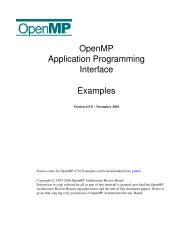D2 3 Computing e-Infrastructure cost calculations and business _models_vam1-final
D2 3 Computing e-Infrastructure cost calculations and business _models_vam1-final
D2 3 Computing e-Infrastructure cost calculations and business _models_vam1-final
You also want an ePaper? Increase the reach of your titles
YUMPU automatically turns print PDFs into web optimized ePapers that Google loves.
e-‐FISCAL: www.efiscal.eu <br />
EC Contract Number: 283449 <br />
much more expensive than sites >1000 cores. Indicative (median <strong>and</strong> average) values for <strong>cost</strong> per core hour are <br />
around € 0.09 for the first category <strong>and</strong> € 0.05 for the latter. <br />
In order to assess whether there is a statistically significant relationship between the size of the sites <strong>and</strong> the <br />
number of FTEs, the <strong>cost</strong> per core <strong>and</strong> the <strong>cost</strong> per core hour for 2011, we have also run univariate Ordinary Least <br />
Square Regressions. The results are shown in Appendix 7.5 <strong>and</strong> confirm that a linear relationship between <strong>cost</strong> <br />
aspects <strong>and</strong> the size of a site in terms of CPU cores cannot be supported. However, there is a statistically <br />
significant negative relation between the number FTEs/1,000 cores <strong>and</strong> the size of the sites in cores. Therefore, <br />
OLS confirms the correlation results. <br />
As a <strong>final</strong> comment, it must be noted that there are parameters that may affect the <strong>cost</strong> hour <strong>cost</strong> among <br />
respondents. A summary of these factors follows: <br />
• Utilisation rates: The utilisation rate (number of CPU hours actually used compared to the theoretical <br />
maximum) plays an important role in calculating the <strong>cost</strong> per core/hour. Core hours that are not used <br />
could be considered as are wasted resources whose <strong>cost</strong> is added to the hours been used (Hawtin et al., <br />
2012). <br />
• Depreciation rates: The prolongation of hardware <strong>and</strong> auxiliary equipment useful life ends up in <br />
decreasing the yearly <strong>cost</strong> per core CPU <strong>and</strong> the corresponding <strong>cost</strong> per core hour. <br />
• Salaries <strong>and</strong> premises <strong>cost</strong>s: These <strong>cost</strong>s have a very local focus <strong>and</strong> are highly influenced by national <br />
circumstances. <br />
• Electricity effectiveness <strong>and</strong> cooling: The PUE of the respondents as well as the climate conditions that <br />
prevail in the site area affect electricity consumption which in turn affects OPEX calculation. <br />
Finally, we present the <strong>cost</strong> breakdown into CAPEX <strong>and</strong> OPEX in all our respondents. <br />
1.2 <br />
1 <br />
0.8 <br />
0.6 <br />
0.4 <br />
0.2 <br />
Cost structure based on size <br />
0 <br />
up to 1,000 cores between 1,000 to between 2,000 to between 5,000 to more than 10,000 <br />
2,000 cores 5,000 cores 10,000 cores cores <br />
OPEX/TOTAL <br />
CAPEX/TOTAL <br />
Graph 5: CAPEX/OPEX per site based on size<br />
The graph (Graph 5) is indicative of the fact that there is heterogeneity in the <strong>cost</strong> structure of sites/centres. <br />
However, it is rather evident that in the vast majority of cases OPEX is not less than 40% of total <strong>cost</strong>s. <br />
e-‐FISCAL : Financial Study for Sustainable <strong>Computing</strong> e-‐<strong>Infrastructure</strong>s <br />
Deliverable <strong>D2</strong>.3 – <strong>Computing</strong> e-‐<strong>Infrastructure</strong>s <strong>cost</strong> estimation <strong>and</strong> analysis – Pricing <strong>and</strong> <br />
Business <strong>models</strong> <br />
49




